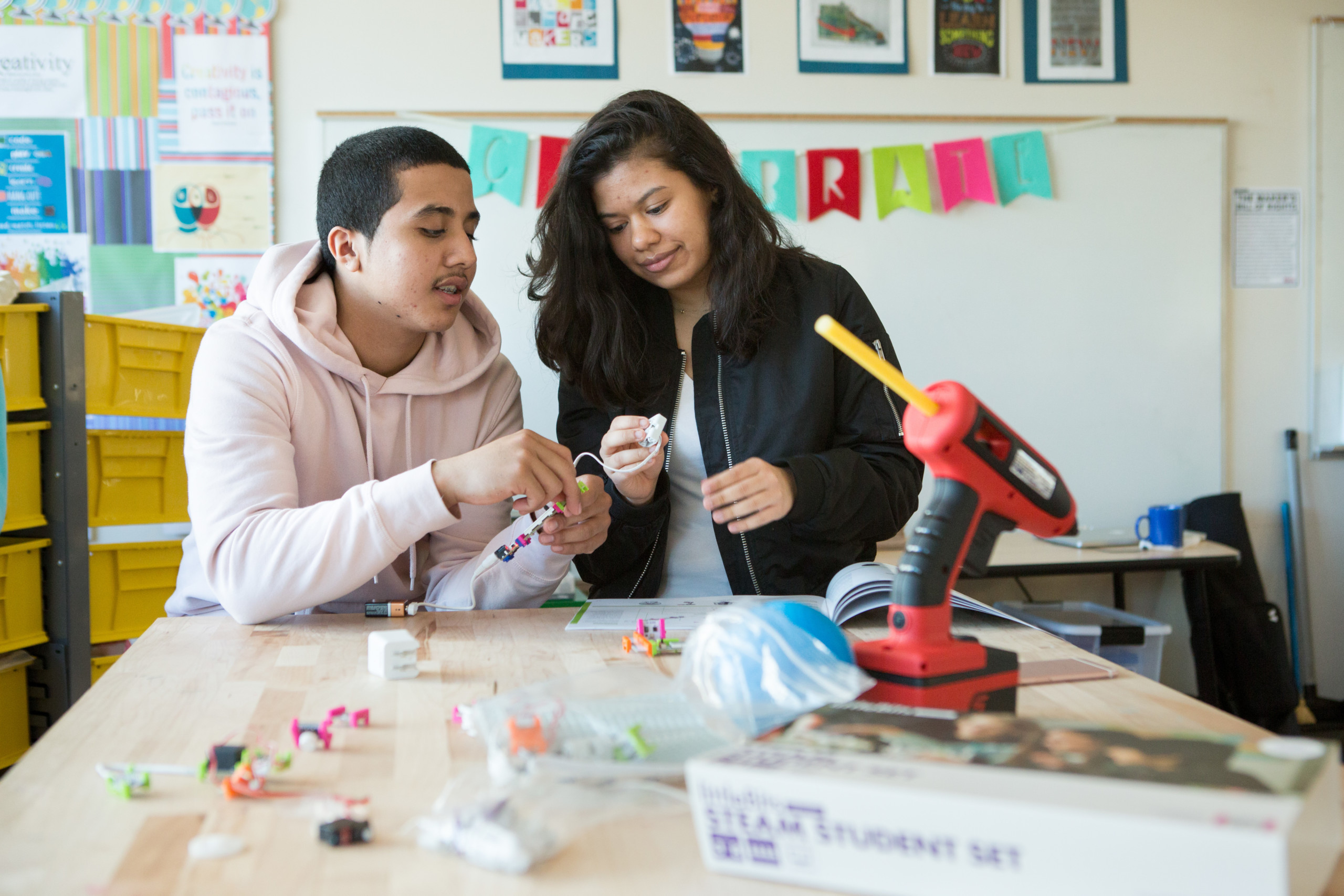
Preparing Rising Talent: How K–12 Can Unlock a Lifetime of Learning
By: Betheny Gross
Introduction: The Case for Focusing on Rising Talent
A few years ago, WGU Labs set out to better understand a group too often overlooked in conversations about education and the workforce: adults who have never participated in any postsecondary education and earn in the lowest income quartile. We call them Rising Talent — roughly 15% of the U.S. working-age population, or about 24 million people.
They are not without skills or ambition. In fact, most are steadily employed, often in the same roles for years. Many simply don’t believe education is right for them or that they are right for education through a combination of negative academic, social, and structural signals. Our current postsecondary systems, which lack affordable, credible, and adaptable pathways to career growth, only push Rising Talent further from education. The systems meant to prepare and connect them to opportunity steer them off course before they’ve had the chance to really imagine their futures.
However, the story of Rising Talent is not one of inevitability. Our analysis found nearly half of those who were considered Rising Talent in 2009 had moved out of that status by 2021—through education, income growth, or both. Change is possible, but 50-50 aren’t good odds.
If we want a different outcome, we must reimagine the postsecondary landscape as a more diverse ecosystem of high-quality pathways — college degrees, apprenticeships, industry certifications, technical credentials, and hybrid models. But to truly change outcomes, K-12 must not only prepare students academically, but also nurture the expectation that they belong in learning and can thrive in the world of work based on doors the educational system can open.
The Circumstances of Rising Talent
This analysis draws on data from the National Longitudinal Survey of Youth 1997 (NLSY97), which has tracked a nationally representative sample of nearly 9,000 people born between 1980–84 from adolescence into adulthood. Rising Talent’s lives are marked by multiple intersecting challenges. Economically, their per-person household income in their late 30s averages just $7,000. Many work full-time and remain in the same position for years, but without recognized credentials, advancement is elusive.
Rising Talent are also more likely to deal with difficult health, emotional, and personal circumstances that only amplify the challenge. Over one-quarter of these individuals reported no computer use, limiting their ability to engage with modern education and career opportunities. Rising Talent are more likely to report poor physical health. Almost one-third do not have healthcare insurance. They were significantly more likely than others to report experiencing trauma, including encounters with gun violence, violent crime victimization, and hospitalization. They were nearly two times as likely to have experienced incarceration. Rising Talent are also more likely than others to report being single, yet on average live in larger households with four members – suggesting significant caretaking responsibilities.
For example, when Rising Talent students were surveyed by Western Governors University (WGU) about their academic concerns, one student replied, “I have spoken with my coach about this, but I feel that between life events and not understanding how to study I have not been successful in [reaching my academic goals].”
Combined, these circumstances can erode confidence, narrow aspirations, and make long-term planning difficult and, certainly, make the traditional degree pathways nearly unthinkable. Their characteristics also present challenges to how to reach them in modern educational systems. To support these individuals, the postsecondary sector has no choice but to move toward more diverse learning pathways.
The K-12 Connection
But simply building new – even robust and credible – pathways likely won’t matter without serious attention to the K-12 pipeline. Our data makes clear that disengagement from learning begins well before adulthood. Rising Talent, on average, reported lower high school GPAs and were more likely to earn their high school diploma after the age of 19; As many as 20% of Rising Talent had not earned a high school diploma or equivalency by their late 30s.
K–12 environments shape expectations in powerful ways. Rising Talent were more likely to report having poor experiences in high school, including high school bullying. Almost 87% of Rising Talent had parents who did not attend college and, as a result, often did not have reinforcements at home to help navigate postsecondary options and experiences.
For example, one WGU student reported, “I have no one” when asked to identify a supporter in their life.
Their expectations also seemed to have been shaped early. As high school students, Rising Talent were more likely to self-report that they were more anxious, less open-minded, and had lower work standards than their classmates.
Structured interviews and reports from WGU faculty and support staff reveal that students often report their prior education experience as having been “difficult, frustrating, or noteworthy for all the wrong reasons.”
These data suggest that expectations for Rising Talent’s success were determined early and carried for decades into adulthood.
What K–12 Must Do Differently
If we want to change the trajectory for Rising Talent, we must start in K–12. Our research offers three strategic shifts that could make a difference:
1. Get Serious about Broadening the Definition of Success
K–12 systems have been slow to fully embrace a broader definition of student success that elevates career-connected learning. There has been promising growth in students’ engagement in Career and Technical Education, with NCES reporting that 43% of U.S. high school graduates in 2019 completed two or more credits in a single CTE field, the definition of a CTE concentrator according to the Perkins law. Two credits of CTE is a low bar to reach, and those same data show that only 25% earned 3 or more credits. States like Tennessee and Texas have slightly stronger expectations, requiring CTE students to earn three or sometimes four CTE credits, and, in the case of Texas, at least one advanced course in the CTE concentration. A more widespread adoption of these models will provide a more robust CTE experience and communicate to students that these workforce-connected pathways are viable and valued pathways.
2. Build Postsecondary Navigation as a Core Skill
K–12 schools must make postsecondary navigation a core, scaffolded skillset with early and sustained exposure to a wide spectrum of postsecondary options. A recent survey found that 75% of graduating seniors don’t feel prepared for college or a career. Yet the choices they make in the next few years — jobs that shape their career path, postsecondary programs that define their futures, and loans that can last decades — carry considerable weight. For a great many students, their parents are similarly uncertain. Over 80% of students want more career planning help from their high schools.
Every student needs structured opportunities to explore career fields, connect with mentors, and visit training or work sites. If we provide all students, not just those we think are heading to four-year colleges, with hands-on support and practice with how to access post secondary learning (e.g. understanding financial aid, comparing program ROI, meeting application deadlines, and understanding admissions requirements of various programs), we will equip students to explore and see future learning opportunities as accessible and available to them.
However, high schools aren’t typically resourced to provide this level of skill-building for all students. Nationally, according to data gathered by NCES, the average counselor-to-student ratio in U.S. schools has improved but still sits at 408:1, nearly double the recommended ratio. Though 90% of students report participating in some career planning in middle and high school, almost half of students report that the career exploration they do have doesn’t explore careers that interest them. Strategies to integrate this skill-building into the curriculum and find ways to pull support from communities and employers outside the school could include partnering with local community colleges on pathways or local employers to boost existing work-learn partnerships and career visibility.
3. Strengthen Supportive Ecosystems
We all have at least one person in our lives who has said, “School just isn’t for me.” This simple statement reveals so much about identity, belonging, and the expectations that have been communicated over years of schooling. Our research on Rising Talent confirms what many of us know intuitively: school experiences in childhood and adolescence shape how we see ourselves, our potential, and where we belong well into adulthood. For many Rising Talent, school was not a place of comfort, support, or success that helped them find the sense of confidence and self-efficacy so critical to academic success.
Decades of research point to concrete strategies that strengthen students’ confidence, belonging, and academic identity. These include focusing on relationships among students and between students and adults, cultivating a student community that celebrates academic success, and helping students build problem-solving skills, growth mindset, academic identity, and building all of these pillars of social and psychological support into a strong ecosystem of support across the school and even into the community, not just one-off programs.
There is no single formula for creating this environment. Strategic mentoring programs that connect students with adults who share the students’ lived experience, peer mentor programs that match older students with younger students, instructional practices that promote growth mindset and normalize challenge, and classroom activities that emphasize peer cooperation and collaboration in class are just some of the research-backed strategies that, together, create a rich environment of support for students.
Beating the Odds
The barriers facing Rising Talent are real, but not inevitable. By reimagining how K–12 defines success, prepares students to navigate postsecondary options, and builds ecosystems of belonging, we can open pathways that lead far beyond a first job—toward a lifetime of learning.
K–12 leaders, policymakers, and education partners must recognize their critical role. By broadening definitions of success, embedding navigation skills into learning, and building supportive ecosystems that infuse multiple postsecondary pathways, we can ensure that students can avoid the Rising Talent mindset and barriers and leave high school not just ready for a job, but prepared for a lifetime of learning.
Betheny Gross is a Research Director at WGU Labs.
Source link


